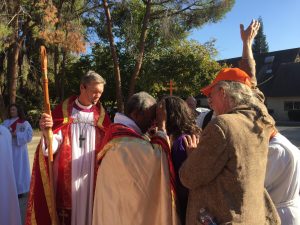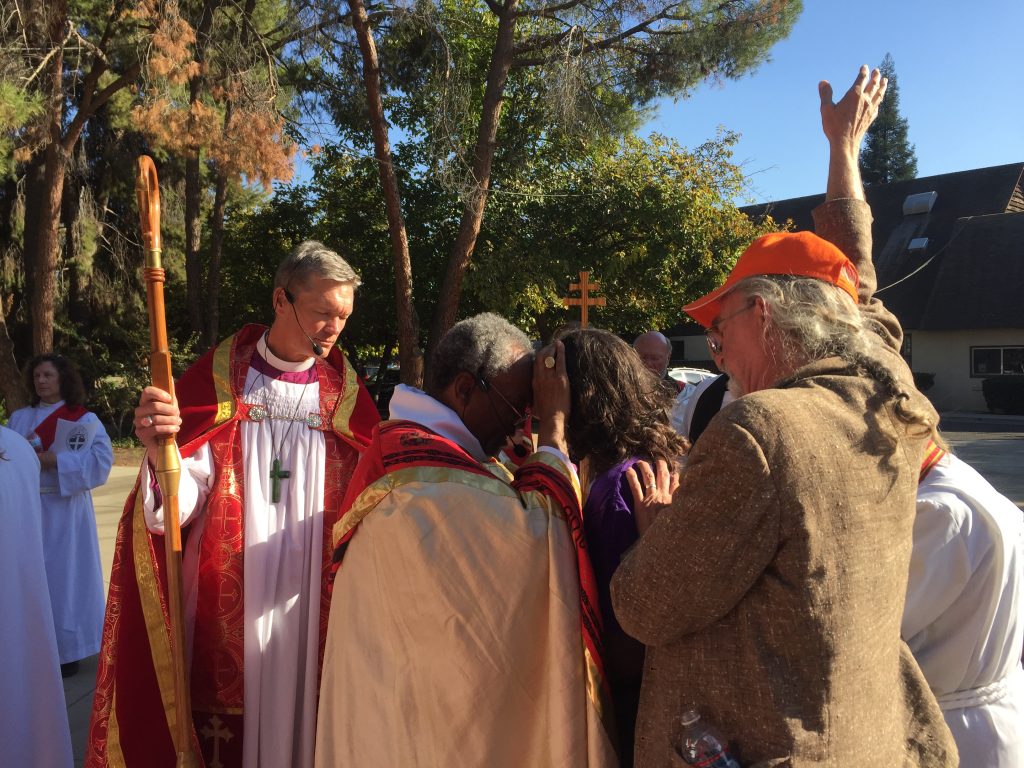by Anne Smith
I went to Fresno because I heard half a year ago that there was going to be a revival with Presiding Bishop Michael Curry. I had to know what that would look like. I was thinking of the Great Awakenings in America and of tent revivals. What would one of these revivals look like in the hands of Bishop Curry?
It’s pretty easy to put together from the Internet what happened (here for example). Events involved a whole lot of testimony plus singing led by the Rev. Lester Mackenzie, some preaching, worship, and the seating of the Rt. Rev. David Rice as the regular bishop of the diocese, no longer provisional. The testimony was from people in various ministries around the diocese, leaders of ministries and beneficiaries of the Episcopal church’s work to help the hungry, the needy, the outcast, the oppressed in the Central Valley of California.

When I got to the cathedral in Fresno, I jumped into the procession making its way along the “neighborhood prayer walk.” I thought we’d be walking to homes and businesses and whatever else might be in the larger neighborhood around the cathedral. This was a walk around the perimeter of the cathedral grounds, though. We heard about the Cathedral of St. James’s feeding program, about the rebirth of St. Paul’s, Bakersfield, about the growth of a bicycle ministry at St. John’s, Stockton, etc. It wasn’t a long walk.
At the end, it was time for worship, and the seating of the bishop. I entered the cathedral for the first time–it was in Anglican hands during the seven years I resided in the Episcopal Diocese of San Joaquin. None of this was what I’d expected. All of it was far more humble. The cathedral space had a kind of magnificence to it, but it also felt very homey to me. It does not soar, the stained glass does not dominate the perimeter, one cannot fail to feel close to the action no matter how far in the back one seats oneself. It’s not made of stone or brick or concrete; its wooden walls and ceiling are painted a light matte brown; there’s not much in the way of polish or luster.
All that you can see if you check out the video on Facebook. But you can’t see what it felt like to have arrived in that room after all that diocese has been through. I visited the church building of St. Francis in Turlock soon after it had been returned by court order to the Episcopal diocese from the schismatic Anglicans who had continued to occupy it. The signs of neglect were saddening, even disturbing: a cruet stained by the wine that had sat in it until it evaporated was a surprisingly distressing sight. But it wasn’t just the physical signs–you could feel it. I am tempted to say that the atmosphere was tainted with the darkness. Darkness that lingered in the corners of that space was more than just physical darkness–but perhaps that is more than I know. But each sacred space, as it returned to the care of the Episcopal diocese, seemed so dark and neglected then.

But at St. James on Saturday–that feeling was not there. I’m told a tremendous amount of work went into restoring that space in the short time that the Episcopal church has been in it now, and while I never saw the shape it had been left in, the effort that has gone into it was evident. Not just because things were clean and bright and cared for, but because light seemed to have cast out darkness in every corner. The presiding bishop made that oft-heard claim that there was a sweet, sweet spirit in that place, and this time it was true.
I belong to another diocese now, but on Saturday I was prouder than ever to have been a part of San Joaquin. I was proud to have been ordained to the priesthood there (the second woman to have that privilege), proud to have been a part of conversations and processes and efforts that are bearing fruit and will continue to bear fruit. I felt the staggering relief of the forgiveness of over $7 million of debt the diocese owed the larger church, debt accrued for the purpose of survival, and so much gratitude because people beyond San Joaquin’s borders are beginning to see what happened there–and are beginning to look to the diocese as a model for the way through.
In my experience, the revival in San Joaquin was an experience of renewed hope. Bishop Michael Curry’s sermon sounded themes we’ve heard him touch on before–the great need for us as Christians to live and love like Jesus, to dare to witness and evangelize no matter how uncomfortable those words may have gotten in Episcopal circles. He preached to us about the work that is to be done along these lines. He quoted Isaiah: “You are my witnesses.” He quoted Jesus: “you will receive power when the Holy Spirit has come upon you; and you will be my witnesses … to the ends of the earth.” He reminded us of our call to testify to what God has done.
That, I think, was the heart of this idea of “revival.” Over three days, the witness of the diocese was shared, and people testified to the ways God’s power has been revealed in their lives. The manifestations of God’s power were truly celebrated, and love and gratitude abounded in me as I prayed and celebrated with these old friends of mine.
For those of us in other settings, the San Joaquin revival can teach us ways we might inspire the people in our own places. The formula–sing, testify, worship–is straightforward enough, perhaps. What people experience depends largely, I think, on other things–our faithful attentiveness to the leading of the Spirit in our particular context, our daily lives spent walking through our own circumstances the way Jesus walked in his, and our cooperation with the creative work God is doing in a new way in each place in a given time.
I wanted to know what this revival would look like; what I imagined I might see was wildly different from the reality that unfolded. There was high value in the reminder that that’s what happens so often when we try to guess what God is up to. Revival, new life, a new way of being won’t look the way we thought it would. The Episcopal Diocese of San Joaquin has been called to a ground-breaking but also ages-old practice of testifying to what it does look like, and celebrating a new way forward. Revivifying, indeed.

